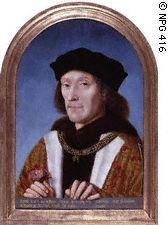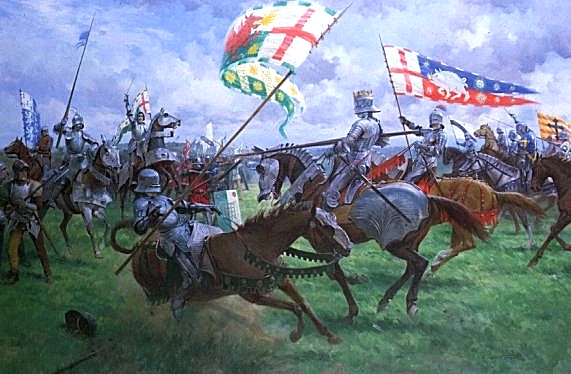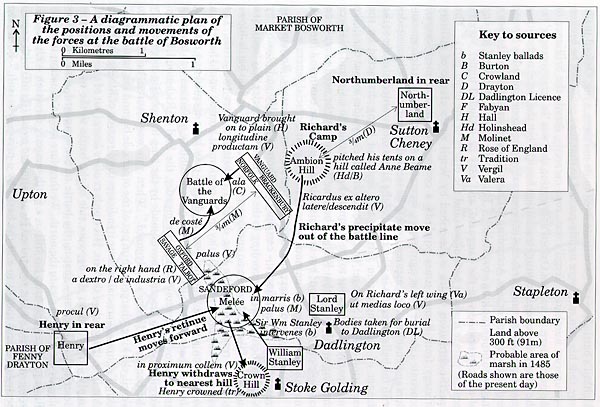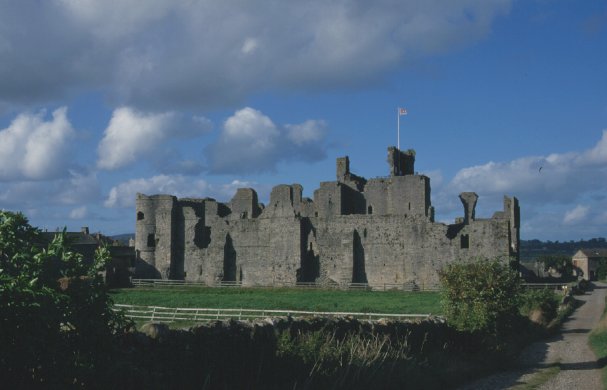To
Die a King
King Richard
III at Bosworth Fielde
|
King Richard III
Artist Unknown NPG 148
National Portrait Gallery London
Abstract
What’s it all about, Alfie?
The Battle of Bosworth in 1485 saw the changing
of power once more between the ducal Houses of York and Lancaster in England.
What is more relevant is how this single battle encapsulates its era and
all of the continual intrigues amongst the parties involved. Visible is
the whitewash of the victor and the modern values awarded to winning, as
opposed to, honour. Even more telling is the centuries long look back at
this time and the reign of Richard III, and the mix of fact, fiction, and
fantasy. So, shall we join the fray and see what Richard and Henry are
up to?
Historical
Background
For in this corner weighing
…
On the Redmoor Plain, south of Market Bosworth
in the Midlands of England, the sun reflected the armour into eyes. Today
was August 22, 1485 and the forces of Henry Tudor and King Richard III
quickly assembled. Their final encounter had been over two years in the
making. Ever since the death of King Edward the IV in April of 1483, the
stage had been set for a struggle for power. This new turn of events opened
possibilities both at home and abroad.
But wait. You can’t tell the
Players without a Program
Research
Report
For it is A House Divided by
The news ricocheted throughout Britain and across the English Channel.
To better understand the report of Edward IV’s death, you need to go back
thirty-some years to find the smoking gun. The Hundred Years’ War between
France and England had left England the loser. During the reign of King
Henry VI, England had lost all of her possessions in France by 1451, save
for the port city of Calais in Flanders. A weak monarchy allowed the two
major houses of nobility in England (Lancaster and York) to battle for
position as they jockeyed for prize and power. One of these clashes
was at the Battle of Wakefield in 1460, where both Richard’s father (Richard,
Duke of York) and brother (Edmund, Earl of Rutland) were killed. This led
to Richard living in exile in Flanders under the protection of Philip the
Good, the Duke of Burgundy. Next year the wind of fortune saw Richard’s
oldest surviving brother, Edward IV, proclaimed King of England over Henry
VI. Richard returned to live in England as the brother to a king. So was
the loss and gain, back and forth, rally and retreat between Lancaster
(Henry VI) and York (Edward IV).
The Royale Hatfields and McCoys
And the story continues. Nine years later, a fleet commanded by the
Earl of Warwick, the Kingmaker, and his son-in-law, Clarence (the brother
to Edward IV no less) set sail from France to reinstate Henry VI. The Spider
King of France, Louis XI, supplied the fleet in return for a promise of
an alliance between England and France against Burgundy. End result? King
Edward and Richard flee into exile to Holland under the protection of Charles
the Bold of Burgundy, their brother-in-law, who is married to Edward and
Richard’s sister, Margaret. Henry VI is released from the Tower of London
and king once more. King Henry VI was king again, but not for long. In
March of 1471, King Edward and Richard set sail from Holland with a fleet
financed by Charles of Burgundy. New results are in. Clarence switches
sides again and re-aligns with his brothers. Eight months later, King Edward
is back in London. What of King Henry VI? After conferring with his advisers,
King Edward has King Henry executed in the Tower the next day in the hopes
of ending the civil war.
Full of Spies, Spiders & Snares
So, what does this all mean? To say the least, confusing! I thank the
someone who invented surnames (last names); probably a historian or a student,
going crazy trying to keep everyone’s first names straight! By 1483, war
or the continual threat of war, in England’s internal struggle had gone
on for over thirty years. Misleading is the idea that the Hundred Years’
War is over. Only in the instance of dealing with outside enemies did the
English Houses unite. England’s main enemy, par excellence, was
France. The Hundred Years’ War was now a Cold War. A French general burned
the coastal town of Sandwich in 1457. King Edward IV had led an expedition
into France in 1475. Louis XI (remember the Spider King of France) bought
Edward off with money and a pension. Richard opposed this peace. In 1479,
busy Louis convinced James III of Scotland to violate the Scottish truce
with England so Louis could engage against Burgundy, England’s ally. Louis
could snare Burgundy in his web, while England was preoccupied with Scotland.
Edward IV designated Richard as commander of the Scottish campaign. Richard
was successful in fending off Scottish raids and even took his army into
Edinburgh.
& Brothers & Heirs
Richard was Edward’s defender and only brother. Did I forget to mention
that Edward had his brother, Clarence, executed in 1478 for treason? These
were tough times. You always needed to know who your enemies were. Spies
were everywhere. Succession of reign, the continuity to maintain control
was all-important. For Edward IV had just two sons: his first named Edward
(the heir) and his second named Richard (the spare). Richard, the Duke
of Gloucester, had one child, Edward. If you have a brother, why do you
name your son after him?
But The King is Dead. Long Live…who is the King?
All this background gets us back to April 1483. Edward the IV is dead.
Edward the V is to be king. He is a minor, 12 years old. More than likely,
Richard, the Duke of Gloucester, is to be the Lord Protector during the
minority of Edward V (the Last Will of Edward IV has not been found). Go
back in time to the last minor king, Henry VI. Henry VI’s Protector was
Richard, Duke of York, holding that office led to the Duke of York’s death
at Wakefield. The reign of a weak king meant trouble. Prone to outside
influence and international powers. Civil war and personal jeopardy. Exile,
disinheritance, and death. In light of this, a joint session of the Lords
and Commons proclaimed Edward V’s uncle, Richard, as king. Richard’s two
nephews, Edward and Richard, were no longer in the line of succession and
remained at the Tower. And from day one of Edward IV’s death, Henry Tudor
lay in wait in Brittany to make a run for the crown as well.
If others lie in wait and call
Within months of King Richard’s coronation, Henry Tudor and his force
(financed by Duke Francis of Brittany) set sail from Brittany hoping to
align with the Duke of Buckingham (another sideswitcher and Richard’s cousin)
and foment an insurrection. The insurrection fizzled like a dud firecracker
and Henry never made landfall and returned to his Brittany base. Buckingham’s
head rolled off the block, yet the threat and taint of Tudor hung like
a pall over Richard throughout his reign. The intrigues, plannings, and
plottings continued. Sporadic naval warfare ensued between France and England
in the English Channel. Trade was disrupted. Who do you trust? King Richard
surrounds himself more and more with his close circle from the North of
England. In 1484, Richard forms the Council of the North as a means to
solidify his power base. This northern power base, in turn, begins to disaffect
some of the nobles from the south. The Council of the North also limits
the power of one Henry Percy, the Earl of Northumberland. Richard keeps
a certain Lord Stanley close to his side. Lord Stanley (his brother is
William) is married to Margaret Beaufort. Margaret’s son by her first marriage
is none other than Henry Tudor, who now waits in exile to claim the throne.
To arms, to arms, for
By the summer of 1485, Richard knows that Henry Tudor will land an invasion
force in England. It was not a matter of if; it was a matter of when. Charles
VIII of France was supplying Henry both men and ships. France remained
an enemy of England, especially in the personage of King Richard. France
remembered that Richard had opposed the truce of his brother with France
in 1475. If Richard could solidify his reign, there was talk within court
circles of Richard’s desire to reopen the campaign against France. Aspirations
for the return of their French holdings, much less, the English claim to
the throne of France still resided in England’s heart. The Scots were engaging
England in naval battles. King Richard was the same Richard, Duke of Gloucester,
that had taken Edinburgh, and Scottish memories were long. The enemies
of before remained the enemies of today.
One Day at Bosworth

Henry Tudor King Henry VII
Artist Unknown NPG 416 National Portrait
Gallery London
When Henry Tudor landed in Wales, he had a force of about four five
hundred consisting of three thousand French and one thousand Scotch mercenaries,
the remainder being Henry’s “English” backers. As Henry advanced eastward,
he picked up some Welsh support and English defections. Richard knew of
his arrival, but delayed his preparations on August 15th to celebrate the
feast of the Assumption. His only son had died the year before. Anne, his
wife, had died in the spring. From Nottingham Castle, King Richard’s banner
waved in the wind with his motto "Loyaulte me lie" (Loyalty binds me) inscribed
on it. The royal call to arms was to meet in the Midlands at Leicester
and stop Henry’s advance to London. Richard’s kingship would be tested
once more. This was the sum of his whole life of nobility: the battles,
the successes, and losses. Loyalty was everything. Whose loyalty could
he trust?
Who’s record is about
The problem with the history concerning this battle, and its causes,
lie in the sources uncovered so far. They are either slanted (usually towards
the House of Lancaster) or unreliable. The two most memorable sources are
Sir Thomas More’s The History of King Richard the Third (More) and
William Shakespeare’s The Tragedy of King Richard the third. More’s
work is dramatic literature, Shakespeare’s play is literary drama. Both
works are not considered history. This is a common consensus as drawn from
both pro and anti-Richardian scholars. Pro and con seems to size up most
of the historians who research King Richard III. Somehow, the opinion is
so polarizing that most do not occupy much of a middle ground. Additionally,
there has been some historical hanky-panky. A portrait of Richard shows
a slight hunchback. Under an infrared light, the “deformity” disappeared.
Not original to the painting, the crooked back was added to conform/confirm
to the tales of Richard's subsequent infamy. The master of the rolls (official
histories) in the Tower during Henry’s reign was John Morton, nephew to
Bishop Morton. One of the key figures in Henry Tudor’s ascension to power
was Bishop Morton. During Richard’s reign, John Rous wrote a history praising
Richard. After Henry’s coming to power, John rewrote a section, now praising
Henry and deriding Richard. An earlier copy pinpointed the changes. Although
certain aspects will forever remain a mystery, there are still new finds
through the years. A recent one is The Lovell Chronicle which gives a decidedly
Yorkist view, versus the Tudor view of the Bosworth Fielde from Bishop
Percy’s Folio. The end of the Lovell Chronicle is titled Bosworth Field
and is as follows:

(The Battle of Bosworth by Graham Turner 48" x 32" Oil on Canvas)
Bosworth Field
On this red moor
on this done day
did the last King of England
fight bravely and sway
Not meekly in fearness
nor courage a’lack
Was to traitors and treason
his Lord was attacked
By Stanley to Henry
who was but a step
By William and Welshmen
as cowards did snatch
the Kingdom of England
for Frenchmen to pat
the crown of royal
on Tudor’s schemed head
and so remove Richard
for whom they had dread
And forget not also
the man of the North
Who nary did move
nor nary sally forth
Yet the Percy who held
his hand on that day
had nary a hand
to help him when pray
he collected those taxes
of King Henry renowned
and Yorkshire remembered
his failure that dawn
and smashed him
and kil’d him
and revenged that pawn
So sadly not Scots
So sadly not Welsh
So sadly not French
did give Henry most help
Was England and English
who rescued the foes
May God have no mercy
for friends like those
For many a lies
were seeded that day
Yet weeds will come forth
of that I can pray
These writings will surface
and straighten the course
and sing the due praise
of King Richard perforce
The Knight of the Rose
Betrayed Lord of the North
I write this in haste
I write this in flight
for Henry’s spies
do see thru the night
They search me out
and wish to snuff
my life and my flame
but ‘tis not enough
For the light of the truth
will yon remember this name
Of Good King Dickon
and so fair named
King Richard the third
I dare proclaim
The Lovell Chronicle
discovered at
Sheriff Hutton Castle in
Yorkshire, England 1999
Source: The Richard Society
And as to what happened

Richard had two to three times as many men in the field compared
to Henry. Richard’s army was a pooling of his various Lord's armies, whereas
Henry’s foreign retinue were paid professionals. For King Richard’s reign
began with a coup d’etat, and now he faced a coup de grace. As the armies
engaged, both Henry and Richard remained out of the fray. Richard placed
the armies of Percy in the rearguard. Lord Stanley and William Stanley
had already established themselves as the flanks. After the initial thrust,
Richard’s vanguard wavered as the Duke of Norfolk fell. Up to this time,
both Lord and William Stanley were not engaged in the fighting. Percy’s
force in the rearguard did not move. Holding off until you could determine
the possible victor and then join the winning side was a tactic that the
Stanley’s and Percy had used before. Henry and his rearguard moved in,
away from the vanguards battle, closer to William Stanley. Suspecting treachery,
Richard gambled. Drawing from his household retainers, with his crown on
his head, he led a charge directly to Henry. If Richard could cut Henry
down before any of the traitors showed their true colors, it would be over.
A trial by ordeal. Once the waverers knew the outcome of the battle, it
would be a fait accompli; and Richard could deal with the traitors afterwards.
The element of surprise could finally disperse the lingering taint on his
reign. As Richard’s band tore into Henry’s camp, the fighting was fierce.
Richard cut down Henry’s standard bearer. Just as Richard came close to
his goal, William Stanley’s men came in from the side. The Royal bee had
landed in venus's-flytrap. Now outnumbered, Richard’s knights were slain
and routed. Most of Richard’s loyal men of the North died in the field
around him. Tradition has it that Richard’s horse, White Surrey, became
stuck in the mud of a swamp as the Welshman pressed on. Richard may have
called for a horse, as he yelled, “Treason,” but it was to keep fighting.
For today, King Richard would live or die a King.
In the end
The end came from William’s Welsh pikemen, as they hacked Richard to
death. More of Richard’s troops were still on their way to Leicester, but
the battle was already over. The whole battle lasted just two hours, one
thousand men died. Henry Tudor was now King, King Henry the VII. Henry
promptly dated the date of his reign the day before the Battle of Bosworth.
Almost half of Richard’s army never engaged in the fight, at least against
the intended enemy, Henry. The naked, butchered body of King Richard was
draped over a horse and tied on like a saddle, by a rope from his neck
to his feet. Henry took his spoils to Leicester and dumped Richard in front
of the town hall for all to see. After two days, the Grey Friars of St.
Mary's buried Richard in an unmarked grave, close to the River Soar. In
contrast, the body of King Henry VI escorted by an honor guard to
St. Paul’s, was buried in the chapel of Chertsey Abbey. At the age of 32,
King Richard the III’s dreams died in the wet soil of his native England—whereabouts
unknown.
"Wer assembled in the counsaill chamber, where and when it was
shewed...that king Richard late mercifully reigning upon us was thrugh
grete treason...piteously slane and murdred to the grete hevynesse of this
citie." Council Minutes of the City of York, 23rd August, 1485
Historical
Significance
It is his story
It is about the last King of England to die in battle, the last stand
for chivalry, the end of feudalism and loyal ties, and the real end of
the Hundred Years’ War. It is about social assumptions regarding history.
Assumption: If princes disappear, then they must be dead. History is not
assuming. Perhaps this could be Thomas More’s tongue in cheek phrase regarding
history, “But of all this point, is there no certainty, and who so divineth
upon conjectures, may as well shoot too far as too short” (More, Grafton
Text 2nd ed., p. 9). In truth, aside from all of the conjectures, it is
the more universal judgement that King Richard was a failure, because he
lost. Or so it is written, or said. Forget the idea that what is written
is must be true. Whether it is in print, on the air, or on the net, know
your source. How does the source write, in what context, and by whom? Is
there an agenda? Ultimately, is the narrative real or made-up, like some
histories or Bosworth Field? For the tale is in the teller, truth be told.

Middleham Castle, Yorkshire
King Richard III's Favorite
Castle
In Memoriam
Plantagenet, Richard
"Remember before God
Richard III, King of England
and those that fell at Bosworth Field,
having kept faith.
Loyaulte me lie"
The Richard III Society
References
Bennett, Michael. The Battle of Bosworth.
Gloucestershire: Sutton Publishing Ltd., 1985.
Buck, Sir George. The History of King Richard
The Third. Ed. Arthur Noel Kincaid. Gloucester: Alan Sutton
Publishing, 1979.
Hughes, Jonathan. The Religious Life of
Richard III. Gloucestershire: Sutton Publishing Ltd., 1997.
Kendall, Paul Murray. Richard the Third.
New York: W.W. Norton & Company, Inc., 1956.
Lovell, Francis Viscount. Bosworth Field The Lovell
Chronicle. Erewhon: Imagination Press, 2001.
Pollard, A.J. Richard III and the Princes
in the Tower. New York: St. Martin’s Press, 1991.
Shakespeare, William. The Tragedy of King
Richard the third. (first edition) Ed. John Drakakis. London:
Prentice Hall, 1996.
Sutton, Anne and Visser-Fuchs, Livia. Richard
III’s Books. Gloucestershire: Sutton Publishing Ltd., 1997.
Tey, Josephine. The Daughter of Time.
London: Peter Davies, 1963.
Tudor-Craig, Pamela. Richard III.
London: National Portrait Gallery 27 June – 7 October 1973 London:
National Portrait Gallery, 1973.
Williamson, Audrey. The Mystery of the Princes.
Towtowa, N.J.: Rowman and Littlefield, 1978
Web Resources
Bosworth
Fielde. from Bishop Percy’s Folio Manuscript. Ballads and Romances Ed.
J.W. Hales and F.J. Furnivall, 3 vols. London, 1868. The Richard III and
Yorkist History Server
Kosir,
Beth Marie Richard III A Study in Historiograpichal Controversy
More,
Sir Thomas The History of King Richard the Third
Murph,
Roxanne C. Richard III: The Making of a Legend Metuchen, NJ: Scarecrow
Press, 1977
Oberdorfer,
Richard Norfolk Academy Pursuing the White Boar Approaches
to Teaching Richard III
Potter,
Jeremy Good King Richard? London: Constable and Company, 1983
Site created by: James
H. Buckingham
"Not a Duke, But a King!"
Bosworth Field ©
2001 James H. Buckingham




